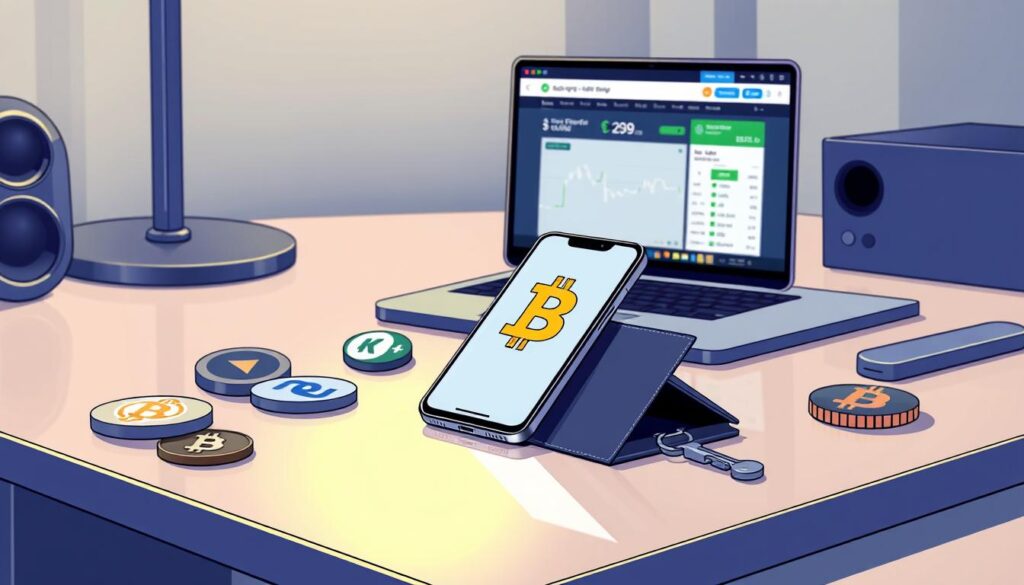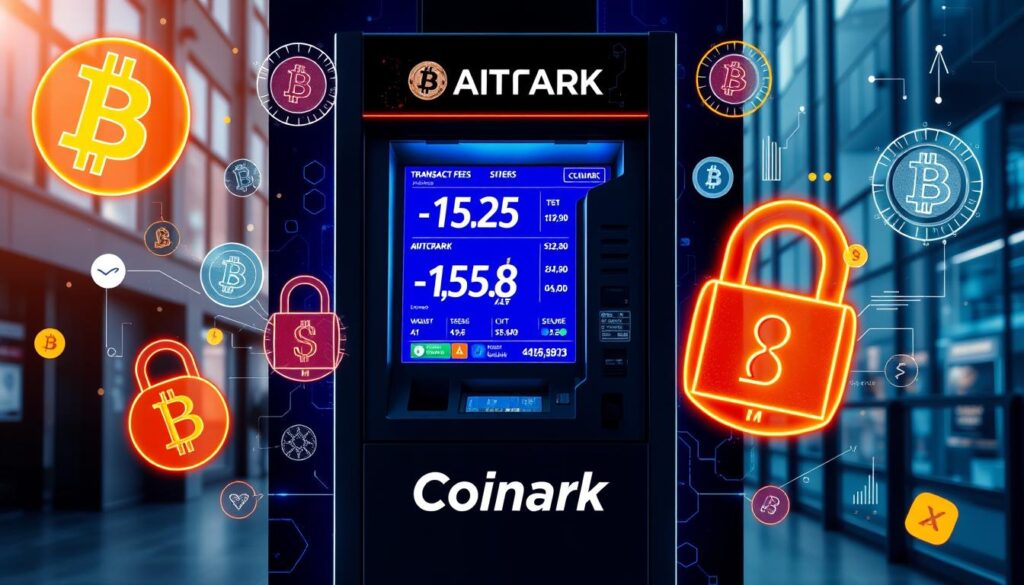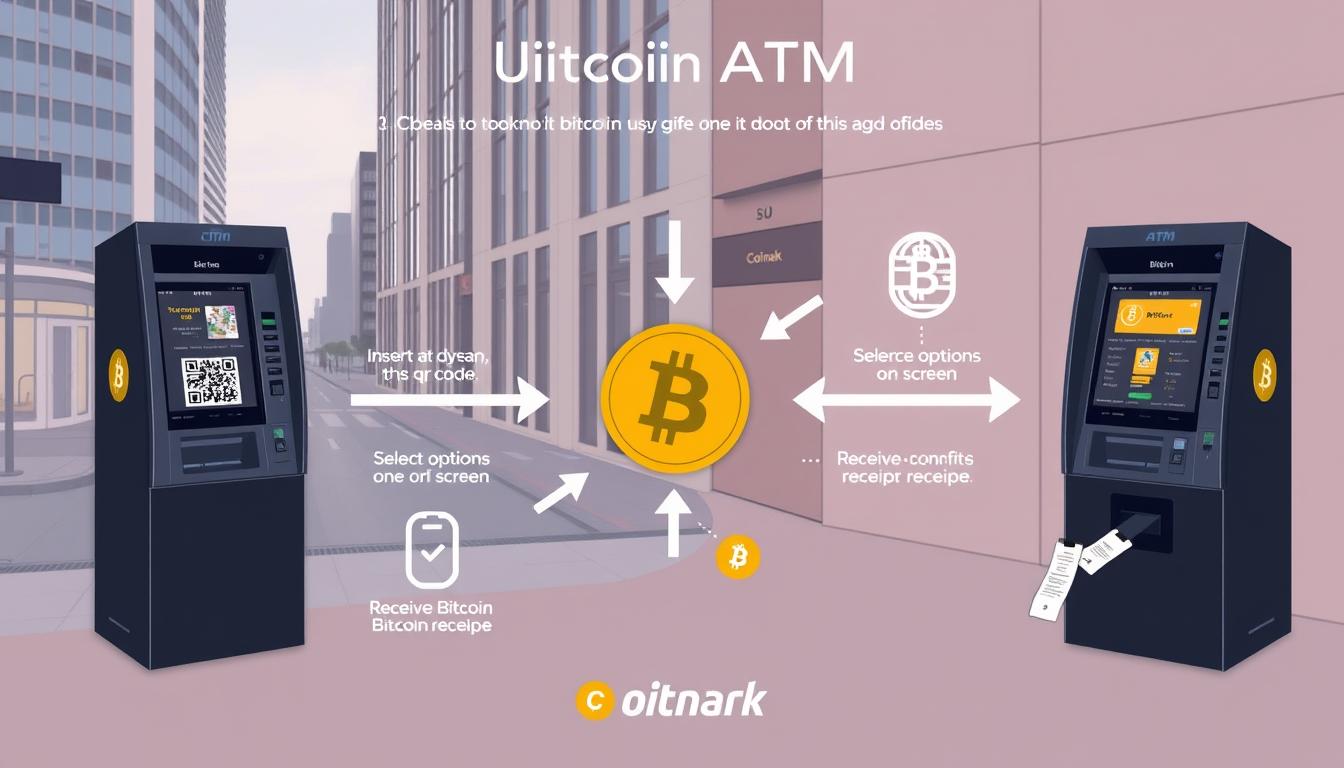Did you know there are about 31,000 Bitcoin ATMs in the United States? They make it easy to turn cash into Bitcoin. But, using them for the first time can be tricky. This guide will help you understand how to use a Bitcoin ATM.
It covers the basics and how to make transactions. You’ll learn everything you need to know.
Key Takeaways
- Bitcoin ATMs offer a quick way to buy and sell Bitcoin.
- Understanding how Bitcoin ATMs work can prevent potential scams.
- Users typically need a cryptocurrency wallet to store their Bitcoin.
- Transaction fees for Bitcoin ATMs can reach up to 20%.
- Always verify your identity before using a Bitcoin ATM to avoid security risks.
Introduction to Bitcoin ATMs
Bitcoin ATMs, also known as Bitcoin Teller Machines (BTMs), have changed how we deal with cryptocurrencies. They let people buy and sell Bitcoin and other digital coins in person. This is easier than using online exchanges.
Now, over 38,000 Bitcoin ATMs are found worldwide. More than 31,000 are in the United States.
More people want to use cryptocurrencies, leading to more Bitcoin ATMs. You can use cash or debit cards to make transactions. This way, you don’t need to go through banks.
Companies like CoinFlip and Byte Federal run these machines. They charge different fees. For example, CoinFlip might charge between 4.99% and 21.90%.
Bitcoin ATMs are easy to find, even in stores like Yesway and Allsup in five states. In California, you can spend up to $1,000 a day. In Minnesota, it’s $2,000.
As more people use Bitcoin ATMs, it’s important to know how they work and the fees. This will help us understand this new financial world.
What is a Bitcoin ATM?
A Bitcoin ATM is a special kiosk for buying and selling Bitcoins and other cryptocurrencies. It’s different from regular ATMs that deal with bank accounts. Bitcoin ATMs connect to cryptocurrency exchanges through the blockchain.
This lets users quickly turn cash into Bitcoin. It makes digital currencies more accessible.
Learning about Bitcoin ATM functionality makes using them easier. Users can put in cash and get Bitcoins in their digital wallets. The process takes 10 to 15 minutes, depending on network traffic.
These machines charge fees, usually between 6% to 17% for buying Bitcoin. Some charge as low as 4%, while others go up to 20%.
Bitcoin ATMs help people without bank access easily get into digital finance. With over 38,000 worldwide, they’re getting more popular, especially in North America. As digital currencies grow, so will the role of Bitcoin ATMs.
Key Benefits of Using Bitcoin ATMs
Bitcoin ATMs offer many benefits that make them great. They are easy to find in places like grocery stores and malls. This makes it simple for people to quickly turn cash into Bitcoin or the other way around.
Convenience and Accessibility
Many people in the US don’t have bank accounts. Bitcoin ATMs help those without bank accounts. They only need a name and phone number for most transactions.
Instant Transactions
Bitcoin ATMs are fast, with transactions taking less than three minutes. This is much quicker than online exchanges. Plus, users get to keep their coins themselves. Many ATMs also support other cryptocurrencies like Ethereum and Litecoin.
| Feature | Bitcoin ATMs | Online Exchanges |
|---|---|---|
| Processing Time | Typically under 3 minutes | Varies, often longer |
| Personal Information Requirement | Minimal | Often extensive |
| Transaction Limits | $1,000 to $15,000 | Varies by exchange |
| Accessibility | High | Medium to Low |
| Availability of Cryptocurrencies | Multiple options | Limited to platform |
Before You Use a Bitcoin ATM
Before you use a Bitcoin ATM, setting up a digital wallet is key. A digital wallet keeps your Bitcoin safe and easy to manage. You can choose from many digital wallets, like Coinbase apps or Ledger hardware wallets, for extra security.
Setting Up Your Digital Wallet
To start, download a Bitcoin wallet app or buy a hardware wallet. Make sure it supports Bitcoin and fits your needs. Use strong passwords and two-factor authentication for extra safety. This keeps your Bitcoin safe from hackers.
Choosing a Secure Wallet
Choosing a secure Bitcoin wallet is crucial. Consider these important factors:
- Access Control: Make sure you control your private keys.
- Encryption Features: Choose wallets with strong encryption.
- Community Reviews: Check what others say to find trusted wallets.
When using a Bitcoin ATM, you’ll need your wallet address, shown as a QR code. Picking the right wallet boosts your security.

How to Find a Bitcoin ATM Near You
Finding a Bitcoin ATM is easy with online tools like Coin ATM Radar. This site shows a map of Bitcoin ATMs near you. Just type in your address or city to see nearby ATMs. You’ll also learn about the cryptocurrencies they support and any fees.
Using Online Resources like Coin ATM Radar
Coin ATM Radar makes finding Bitcoin ATMs simple. It shows you where to go and gives details about each ATM. You can find out:
- Supported transaction types (buy or sell)
- Available cryptocurrencies (Bitcoin, Ethereum, etc.)
- Operator details for each ATM
- Transaction fees and limits
Filtering Search Results
Coin ATM Radar lets you filter search results. This helps you find the perfect ATM for you. Here are some filters you can use:
| Filter Criteria | Description |
|---|---|
| Currency Supported | Choose from various cryptocurrencies like Bitcoin or Ethereum. |
| Transaction Type | Determine if you want to buy or sell cryptocurrency. |
| ATM Operator | Check which company operates the ATM (e.g., Coinme, Bitstop). |
| Location Filters | Narrow the search by specific cities or zip codes. |
Step-by-Step Guide to Using a Bitcoin ATM
Using a Bitcoin ATM might seem hard at first. But, it’s really simple once you know the steps. This guide will show you how to put cash into a Bitcoin ATM, send money, and take cash out easily.
How to Deposit Cash into Bitcoin
To put cash into a Bitcoin ATM, start by picking “Buy Bitcoin” on the machine. You’ll need to enter your phone number for a verification code. Then, scan your wallet QR code with the ATM’s scanner.
Put in the cash you want to convert. The ATM will show how much Bitcoin you get. Confirm the deal to finish it. This makes a Bitcoin transaction from your cash.
How to Send Money Using a Bitcoin ATM
To send money, pick the “Send Money” option. You’ll need to verify your identity first. Then, enter the recipient’s Bitcoin address.
You can scan their QR code or type it in. After putting in the cash, check the details. Then, finalize the transaction.
How to Withdraw Cash from a Bitcoin ATM
To get cash out, choose “Withdraw Cash” on the screen. You’ll need to verify your identity with your phone number. Next, enter your Bitcoin address.
Send the Bitcoin to the address the machine shows. Confirm, and the ATM will give you your cash. This ends the cash withdrawal smoothly.
| Action | Steps | Notes |
|---|---|---|
| Deposit Cash |
|
Transaction fees often range from 6% to 17% |
| Send Money |
|
Double-check the recipient Bitcoin address to avoid errors |
| Withdraw Cash |
|
Cash withdrawal is instant after verification |
Understanding How Bitcoin ATMs Work
Bitcoin ATMs make it easy to use cryptocurrency. When you use one, you enter your info and wallet address. This starts the transaction.
These machines check and confirm your money moves fast. They use blockchain tech for this.
Using a Bitcoin ATM is simple. You can put in cash to get Bitcoin or take out cash if you sell it. You just scan your wallet QR code for quick and safe transactions.
Bitcoin ATMs are getting more popular, especially in the U.S. with over 31,000. They make using cryptocurrency easy. Blockchain tech keeps your transactions safe and clear.
Looking at Bitcoin ATM features can help you choose. Each one is different.
| Feature | Standard Bitcoin ATM | High-Fee ATM |
|---|---|---|
| Transaction Fee | 6% – 17% | 15% – 20% |
| Transaction Speed | Instant Confirmation | Instant Confirmation |
| Wallet Integration | Supports Standard Wallets | May Limit Choices |
| Location Accessibility | High | Moderate |
More people are using Bitcoin ATMs. It’s key to know how they work. Every transaction helps grow cryptocurrency. It shows blockchain’s big role in today’s money world.
Transaction Fees and Security Considerations
It’s important to know about Bitcoin ATMs. This section will talk about fees and safety tips for using them.
Understanding Transaction Fees
Bitcoin ATM fees can range from 5% to 25% of the transaction. There are also network charges from $1 to $3. These fees help cover the costs of running the machines.
- The average Bitcoin ATM exchange fee in the USA is 5% to 25%.
- Big operators might charge from $3 plus 7.1% to 17.6% for transactions.
- Hidden fees can include limits on withdrawals and extra charges for non-registered users.
- Going over certain transaction limits can cost extra.
Before using a Bitcoin ATM, know the fees. This helps avoid unexpected costs.
Safety Measures for Using Bitcoin ATMs
Keeping safe is key when using Bitcoin ATMs. Here are some important tips:
- Do transactions in bright, busy places for better safety.
- Make sure the ATM is real by checking for proper branding and reviews.
- Use machines from trusted providers, like Coinark Bitcoin ATM, at 2340 W Grandview Blvd, Erie, PA 16506.
- Turn on two-factor authentication on digital wallets for extra security.
By following these tips, you can stay safe and avoid risks when using ATMs.

Troubleshooting Common Bitcoin ATM Issues
Using Bitcoin ATMs can sometimes be tricky. Knowing how to deal with common problems makes transactions easier. We’ll look at delays and technical issues that might pop up.
Common Transaction Delays
Delays in Bitcoin ATM transactions often happen because of network confirmation times. These can take up to an hour, which might worry users. It’s important to stay patient and wait for the transaction to go through.
Users can check their wallet for updates. This helps make sure the transaction is being processed right. Usually, checking the status will clear up any doubts.
Technical Challenges
Bitcoin ATMs can also face technical problems. If you run into issues, first make sure your phone number and verification code are correct. If problems still happen, it’s time to contact the ATM provider’s support.
Support teams can help fix the issue. They make sure your transaction goes through smoothly and answer any other questions you might have.
| Issue | Description | Resolution |
|---|---|---|
| Transaction Delays | Delays may occur due to network confirmation time. | Wait up to an hour, check wallet updates. |
| Incorrect Information | Issues can stem from entering incorrect details. | Double-check phone number and verification code. |
| ATM Malfunction | Hardware or system issues may arise. | Contact the ATM provider’s support for assistance. |
| Transaction Limits | Users may hit daily limits with high transactions. | Verify daily limits and plan transactions accordingly. |
Advanced Uses of Bitcoin ATMs
Bitcoin ATMs are not just for buying Bitcoin. You can also use them to purchase other cryptocurrencies like Ethereum, Litecoin, and Tether. More multi-currency ATMs mean easier access to different digital assets. This opens up new chances for those into cryptocurrencies and investors.
Buying Other Cryptocurrencies
Using a Bitcoin ATM with crypto ATM options is easy. Just pick the cryptocurrency you want and pay with cash. This way, you can try out different digital currencies without the hassle of online exchanges.
Using Bitcoin ATMs for Business Transactions
Businesses can attract more customers with Bitcoin ATMs for business. Having a Bitcoin ATM in your store lets customers pay with digital money. This makes customers happier and can bring in extra money through fees.
By offering cryptocurrency in commerce, businesses can keep up with the fast-changing market. As more people use cryptocurrencies, Bitcoin ATMs will become even more common. This will give both customers and businesses new ways to use digital money.
Regulatory Landscape for Bitcoin ATMs
The rules for Bitcoin ATMs change a lot and differ by place. In the United States, 60% of these machines are found, making it a big spot for Bitcoin deals.
Bitcoin ATM owners must sign up with the Financial Crimes Enforcement Network (FinCEN) to follow the rules. They face issues with Anti-Money Laundering rules from the Bank Secrecy Act. To follow these rules, they need to have clear policies, a compliance officer, training, and audits.
Bitcoin providers must also follow Know Your Customer (KYC) rules. This means they have to check users to lower risks and make sure they follow the law. Bitcoin ATMs in places like malls and airports help with digital money but also bring up compliance problems.
Keeping transactions private is still a big challenge, especially with ID checks. Users might also face limits on how much they can do. Ways to keep things private, like using special wallets or mixing services, are getting more popular.
As more people want private transactions, the rules for Bitcoin ATMs will likely change. With over 38,000 Bitcoin ATMs worldwide and new tech, the rules will keep adapting.
Conclusion
This guide is a complete resource for those wanting to use Bitcoin ATMs. It covers how to use them and the steps involved. With over 34,000 Bitcoin ATMs in more than 150 countries, getting digital currency is easier than ever.
Knowing about fees, which can be 5% to 25%, helps users make smart choices. As Bitcoin ATMs grow, they could change how we use cryptocurrency. For example, the Coinark Bitcoin ATM in Erie, PA, makes starting easy.
In short, this guide helps people dive into the crypto world. It shows how important Bitcoin ATMs are for getting digital assets. Using these machines can lead to many benefits and new ideas in the crypto world.
FAQ
What is a Bitcoin ATM?
How do I use a Bitcoin ATM?
Where can I find a Bitcoin ATM near me?
What are the transaction fees for Bitcoin ATMs?
Is it safe to use a Bitcoin ATM?
Can I buy other cryptocurrencies at a Bitcoin ATM?
What should I do if I encounter technical issues with a Bitcoin ATM?
How do I ensure my digital wallet is secure?
What is the regulatory landscape surrounding Bitcoin ATMs?
Source Links
- What Are Bitcoin ATMs And How Do They Work? | Bankrate
- What Is a Crypto ATM?
- How to use Bitcoin ATM
- What Is a Bitcoin ATM? | The Motley Fool
- How To Use Bitcoin ATM – A Begginer’s Guide Gow They Work
- What Is a Bitcoin ATM? | Built In

